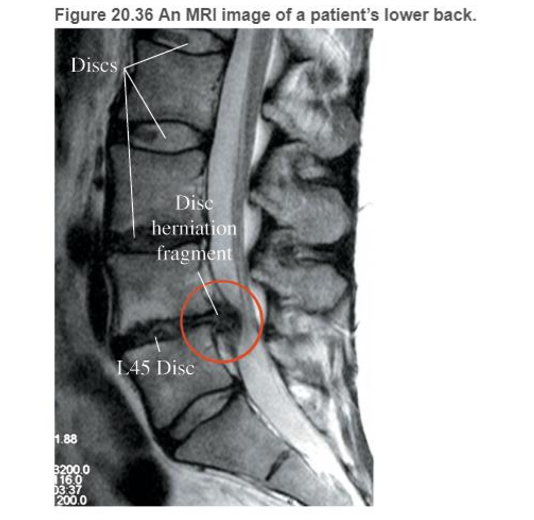
Concept explainers
BIO Power lines—do their magnetic fields pose a risk? Power lines produce both electric and magnetic fields The interior of the human body is an electrical conductor, and as a result, electric fields are greatly reduced in magnitude within the body The electric fields inside the body from power lines are much smaller than electric fields normally existing in the body.
However, magnetic fields are not reduced in the body Earth's magnetic field, approximately
T, is very small and not regarded as a health threat Thus, it is interesting to compare Earth's magnetic field to fields produced by high power lines The magnetic field B produced at a distance r from a straight wire with an
The magnetic field from a high-voltage power line located 40 m above the ground carrying a 100-A current is much smaller than Earth's
Wires that provide electric power for household appliances also produce electric and magnetic fields The current in the wire for a 500-W space heater is about 5 A. With the wire located several meters from your body the magnetic field of such an appliance is somewhat smaller than Earth s magnetic field By comparison laboratory mice lived for several generations in 0.0010-T magnetic fields (20 times Earth s magnetic field) without any adverse effects
During the last three decades, electric power use has increased the magnitudes of the

Using your answer to Problem 20.48, determine the quantity closest to the amount that the auxiliary magnetic field causes the magnetic field to vary over a 0.20-m region of the body being mapped by MRI.
a. 4 T
b. 2T
c. 0.002 T
d. 0.02 T
e. 0.2 T
Want to see the full answer?
Check out a sample textbook solution
Chapter 20 Solutions
Modified Mastering Physics with Pearson eText -- Access Card -- for College Physics: Explore and Apply (18-Weeks)
Additional Science Textbook Solutions
Chemistry: Structure and Properties (2nd Edition)
Cosmic Perspective Fundamentals
College Physics: A Strategic Approach (3rd Edition)
Campbell Biology in Focus (2nd Edition)
Microbiology: An Introduction
Human Anatomy & Physiology (2nd Edition)
- pls help on thesearrow_forward20. Two small conducting spheres are placed on top of insulating pads. The 3.7 × 10-10 C sphere is fixed whie the 3.0 × 107 C sphere, initially at rest, is free to move. The mass of each sphere is 0.09 kg. If the spheres are initially 0.10 m apart, how fast will the sphere be moving when they are 1.5 m apart?arrow_forwardpls help on allarrow_forward
- 19. Mount Everest, Earth's highest mountain above sea level, has a peak of 8849 m above sea level. Assume that sea level defines the height of Earth's surface. (re = 6.38 × 106 m, ME = 5.98 × 1024 kg, G = 6.67 × 10 -11 Nm²/kg²) a. Calculate the strength of Earth's gravitational field at a point at the peak of Mount Everest. b. What is the ratio of the strength of Earth's gravitational field at a point 644416m below the surface of the Earth to a point at the top of Mount Everest? C. A tourist watching the sunrise on top of Mount Everest observes a satellite orbiting Earth at an altitude 3580 km above his position. Determine the speed of the satellite.arrow_forwardpls help on allarrow_forwardpls help on allarrow_forward
- 6. As the distance between two charges decreases, the magnitude of the electric potential energy of the two-charge system: a) Always increases b) Always decreases c) Increases if the charges have the same sign, decreases if they have the opposite signs d) Increases if the charges have the opposite sign, decreases if they have the same sign 7. To analyze the motion of an elastic collision between two charged particles we use conservation of & a) Energy, Velocity b) Momentum, Force c) Mass, Momentum d) Energy, Momentum e) Kinetic Energy, Potential Energyarrow_forwardpls help on all asked questions kindlyarrow_forwardpls help on all asked questions kindlyarrow_forward
 College PhysicsPhysicsISBN:9781938168000Author:Paul Peter Urone, Roger HinrichsPublisher:OpenStax College
College PhysicsPhysicsISBN:9781938168000Author:Paul Peter Urone, Roger HinrichsPublisher:OpenStax College Physics for Scientists and Engineers, Technology ...PhysicsISBN:9781305116399Author:Raymond A. Serway, John W. JewettPublisher:Cengage Learning
Physics for Scientists and Engineers, Technology ...PhysicsISBN:9781305116399Author:Raymond A. Serway, John W. JewettPublisher:Cengage Learning Physics for Scientists and Engineers: Foundations...PhysicsISBN:9781133939146Author:Katz, Debora M.Publisher:Cengage Learning
Physics for Scientists and Engineers: Foundations...PhysicsISBN:9781133939146Author:Katz, Debora M.Publisher:Cengage Learning College PhysicsPhysicsISBN:9781305952300Author:Raymond A. Serway, Chris VuillePublisher:Cengage Learning
College PhysicsPhysicsISBN:9781305952300Author:Raymond A. Serway, Chris VuillePublisher:Cengage Learning College PhysicsPhysicsISBN:9781285737027Author:Raymond A. Serway, Chris VuillePublisher:Cengage Learning
College PhysicsPhysicsISBN:9781285737027Author:Raymond A. Serway, Chris VuillePublisher:Cengage Learning





